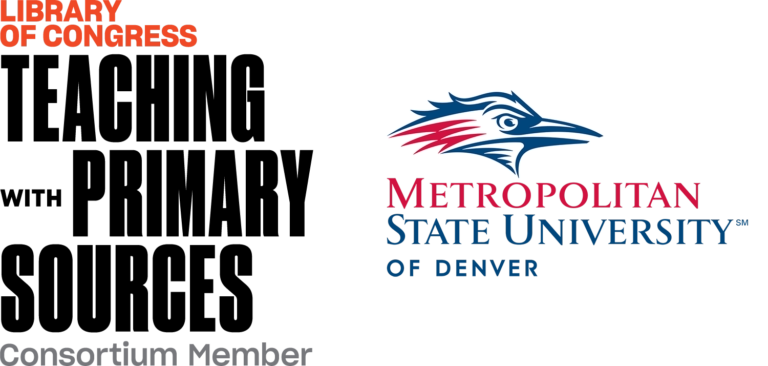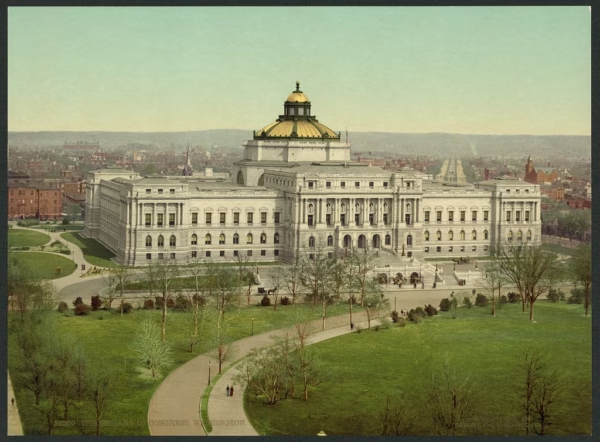
The TPS Teachers Network is a professional learning community managed through a Teaching with Primary Sources (TPS) grant to the Metropolitan State University of Denver (MSU Denver). The Network contributes to the Library of Congress’s vision of connecting to all Americans by providing an online platform for educators as they learn strategies for teaching with Library of Congress digitized resources. It addresses TPS program goals, which align with the Library’s strategic initiatives to expand access, strengthen capacity, and foster innovation.
The Network extends the Library’s reach to educators in all 50 states, the District of Columbia, and US territories. Network members include PreK-12 teachers, curriculum specialists, administrators, librarians, archivists, museum educators, university faculty, undergraduate and graduate students, and staff from non-profit and community organizations. Responses from a 2022 survey of TPS Teachers Network members indicated that nearly half of them work in underserved communities in rural and urban areas.
As of November 2024, nearly 16,000 educators have joined the Network. On average, about 1300 of these members visit the Network each month. In the survey, respondents reported that they come to the Network to find teaching ideas (74.42%), find primary sources to use with learners (72.36%), be part of a community of professionals (72.09%), and learn more about the Library of Congress resources (59.30%).
Members share primary sources, teaching strategies and materials, articles, research studies, and notices about professional development opportunities with other educators who have the same or corollary teaching interests.
Cadres of trained mentors, special project coordinators, and professional development specialists working within the Network encourage collegial resource sharing and ensure that discussions remain fresh, informative, and relevant. The Network helps members sustain their use of the Library’s unparalleled and freely available materials to benefit learners now and in the future.
TPS Teachers Network Community
The Network is an online community that helps educators grow in their use of Library of Congress resources. It connects teachers around topics of common interest based on their content focus, teaching environment, and professional background.
Through the Network, educators can access teaching strategies, materials, just-in-time resources, and advice on demand focused on using primary sources effectively. For example, a user might log on to the Network to find a primary source that connects to a current event, learn a new inquiry strategy, or seek advice about teaching a difficult topic.
Teachers tend to work in isolation, often as the lone adult in a classroom of students. The volume and demands of their work leave little opportunity for in-depth interactions with fellow educators during the school day. In addition to providing teaching resources and strategies, the Network offers opportunities for teachers to join a community of peers with the same goals and aspirations.
Also, within the Network, teachers expand their knowledge of teaching with primary sources through interactions with Library staff, Network mentors, and TPS Consortium members working in non-profits, public libraries, and cultural institutions outside of K-12 classrooms.
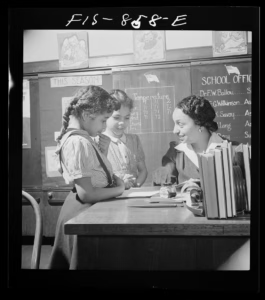
Student and Teacher Inquiry
Across all learning environments, primary sources facilitate inquiry by supporting an iterative process that encourages student curiosity and questioning. When primary sources are integrated into inquiry instruction, students become drivers of their learning by following individualized research paths and creating products that show evidence of learning. The inquiry process involves interrogating and analyzing various formats of primary sources (maps, photographs, sound recordings, newspaper articles, graphs, videos, etc.) with questions like: Who created the primary source? What was its intended message? Why was the source created? Who was the intended audience? Whose perspective is missing?
The Network allows teachers to improve their ability to guide student inquiry with primary sources. Teachers engage in their own inquiries by asking questions like: How do I encourage meaningful questions? How can I use primary sources to provide context and build meaning and content knowledge? What instructional strategies do I use to facilitate investigation? How do I emphasize the power of student reflection? What assessment strategies can confirm desired learning? Teachers can investigate these questions using the Network’s large, searchable archive of digital materials and instructional strategies based on Library of Congress primary sources.
Supportive and Enriching Environment
Research shows that continuous engagement with other educators and support over time help educators transform instructional practice. Educators who represent a wide range of professional settings, curricular interests, demographics, and geographic locations post teaching materials and strategies and initiate discussions and reflections. The Network maintains a culture of acceptance, understanding, and support with people who understand the professional and political environment.
The Network allows members to engage with peers, access a wealth of teaching materials and ideas, and interact with recognized educational leaders. Regardless of the time or day of the week, teachers can find learning materials and follow self-directed learning paths based on their instructional goals and professional settings.
Network Groups

The Network is organized with over 90 groups related to professional roles, content areas, and primary source pedagogy, which helps members connect to topics of interest and educators in similar situations. For example, members can join content-related groups such as Arts, STEM, Social Studies, and English Language Learners; join geographically based groups such as Montana, Puerto Rico, or New York; or participate in pedagogical groups such as methodologies, the Question Formulation Technique (QFT), instructional strategies, and skill building. The richness of these discussions lies in the feedback and suggestions that members offer one another. For example, a teacher might suggest adding another primary source, perhaps in a different format, such as a historical newspaper or audio recording. Or members might expand on a teaching idea to meet the needs of very young learners, English Language Learners (ELL), students with disabilities, gifted students, etc.
In addition to belonging to specifically focused groups, every Network member belongs to the TPS Commons, an inclusive group comprising all members of the growing Network community of nearly 16,000 current members. In the Commons group, Network members post wide-ranging content of interest to educators across grade levels and content areas. For example, previous posts have described strategies for pairing books with primary sources and connecting historical maps to current events. Members also post information about professional development, emerging educational trends, and primary source activities for the upcoming school year.
TPS Teachers Network Mentors
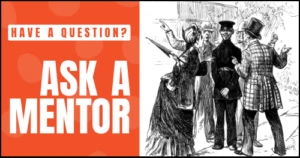 In 2010, Library staff embarked on a rigorous nationwide application and selection process to find experienced teachers, librarians, and university faculty members who had excelled in online education environments and had extensive experience teaching with primary sources. These outstanding educators served as advisors and testers during the early planning, development, and beta stages of the TPS Teachers Network. In 2015, they completed the first version of the Mentor course to become official TPS Teachers Network Mentors. Currently, there are 15 trained mentors active in the TPS Teachers Network.
In 2010, Library staff embarked on a rigorous nationwide application and selection process to find experienced teachers, librarians, and university faculty members who had excelled in online education environments and had extensive experience teaching with primary sources. These outstanding educators served as advisors and testers during the early planning, development, and beta stages of the TPS Teachers Network. In 2015, they completed the first version of the Mentor course to become official TPS Teachers Network Mentors. Currently, there are 15 trained mentors active in the TPS Teachers Network.
The mentors keep the Network community active, current, lively, collegial, and supportive. They share up-to-date pedagogy and best practices in teaching with primary sources, start discussions, and comment on users’ posts. Mentors create and share content like albums and inquiry starter sets, connect Network members to library resources, and provide suggestions for using them in the classroom. By playing a curatorial role, they help users find and utilize the rich archive of materials already in the Network.
Levels of Engagement

Broadly speaking, educators have different comfort levels and habits of engaging with online professional development communities. Based on qualitative research and website analytics, the Network administrative team has identified three notable and fluid levels of Network engagement and interaction: Readers, Reactors, Content Creators, or a combination of the three.
Readers go to the Network to find practical, applicable, and relevant primary source materials and strategies to use with their students. They add value to the Network’s dynamic environment by incentivizing other members to contribute fresh content.
Reactors respond to others’ posts by liking, commenting, or sharing. They tend not to initiate discussions, but their interactions keep the Network lively and interesting. Reactors extend and deepen conversations that others have started by adding comments and relevant links.
Content Creators initiate discussions, create albums, share links to primary sources or articles, tag users to highlight contributions other members have made, and write and share pedagogical strategies. They may also test strategies and describe teaching experiences to other Network users.
The Network supports each type of user with information, functionality, and messaging that meets members where they are.
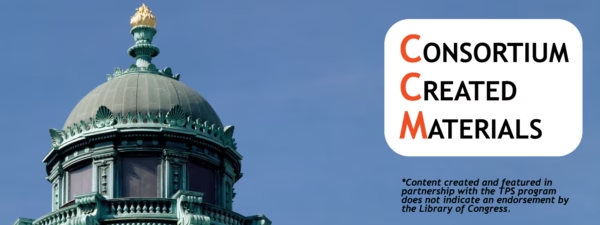
Supporting the Consortium
TPS Consortium members help design and deliver the TPS Program by providing professional development and creating learning tools and materials based on Library of Congress resources. This group of current and former TPS grantees comprises more than two hundred local, regional, and national educational organizations that reach approximately 18,000 teachers annually who want to strengthen their instruction with primary sources.
TPS Consortium members introduce hundreds of users to the Network yearly to extend the impact of their professional development workshops, academic courses, and conference presentations. By incorporating the Network in their outreach to teachers, TPS Consortium members encourage continuous engagement over time with one another and the Library of Congress.
TPS Consortium members report that the Network is a trusted, reliable, and responsive source for enhancing teachers’ comfort and knowledge using Library of Congress primary sources. They appreciate that the platform allows teachers to communicate and collaborate while creating, discussing, sharing, and curating teaching material and strategies. Consortium members also value the ability to create communities of practice that support their grant goals within the Network.
Many Consortium members value the TPS Teachers Network mentors’ contributions by enriching conversations with sources and teaching ideas. For example, mentors bring unique perspectives and knowledge, honed through their vast teaching experience, to topics such as media literacy, technology integration, local history, literature, performing arts, science, civics, Native American history, and African American studies. Consortium members collaborate with mentors, relying on their knowledge of the Library of Congress website and archived Network resources to enhance their professional development events.
The Network includes functionality that offers several course management features. After Consortium members invite course participants to join groups, they can create and host discussions, share course resources, and give assignments, which participants post on the Network.
The Network plays an essential role in administering the TPS Program. The Consortium Created Materials (CCM) website is a repository of grant-funded TPS materials created by TPS Consortium members as required by each grantee’s cooperative agreement. On the CCM, Consortium members upload ideas, information, and materials and often find collaborators to design and deliver TPS projects. The CCM is a searchable database accessible to Consortium members, TPS Network members, and the public. Library staff answers occasional Congressional queries about grantee activities using information from the CCM.
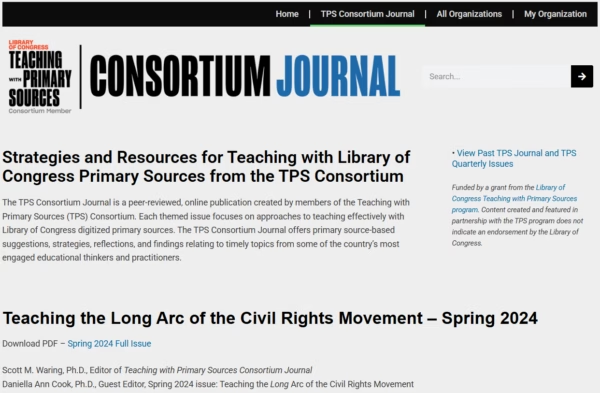
The Network also hosts policies, content, and discussions specific to the TPS Program. The Network is flexible enough to allow Library staff to revise content and page configurations quickly.
The Network is a powerful communication tool for TPS Consortium members. Several Network-specific communication channels assist with making content easily searchable and accessible and updating members on ongoing activity. The Insider is a monthly blog post intended to inspire users to fully engage in the Network with in-depth looks at new technological developments, content, and member contributions while connecting activity in the Network to overall educational trends. The Best of the Month is a monthly illustrated newsletter of curated discussions and albums, a spotlight on teaching strategies, user tips, and monthly membership statistics. The TPS Consortium Update is a monthly newsletter available to readers inside and outside the Network that shares news from Consortium members and Library staff, including new resources, enrichment opportunities, workshops, and courses.
The TPS Consortium Journal is a peer-reviewed, online publication created by Teaching with Primary Sources (TPS) Consortium members. Each themed issue focuses on approaches that TPS Consortium members use to teach effectively with primary sources. The TPS Consortium Journal offers primary source-based suggestions, strategies, reflections, and findings relating to timely topics.
Discovering, Curating, and Creating Instructional Content
The TPS Teachers Network offers a constantly evolving learning environment where educators can engage in discussions with peers steeped in grade-level and content knowledge across learning communities. They find and share timely, practical, purposeful resources and approaches for using Library of Congress materials specific to their teaching goals and settings. The Network functions as a searchable archive of materials teachers use and adapt to meet their unique teaching goals.
The Network is a workspace where one can work out ideas and make mistakes. It provides teacher-generated materials, from initial ideas to polished and vetted material, and support for developing and disseminating educator-created materials. The Network generates and disseminates various learning materials developed by education professionals, with ideas and classroom-ready resources for different learning contexts and situations.
Groups
Members can join groups to discuss areas of interest based on content, grade level, topic, and professional role. There are currently 80 groups, including Maps and Geography, Civil Rights, Arts and Primary Sources, STEM, Rural Education, Partnering with Museum Educators and Archivists, and Primary Sources in Elementary Education. In addition to joining groups of interest, all members belong to the TPS Commons, a collective space for finding and sharing ideas, resources, and teaching strategies with the entire Network.
Albums
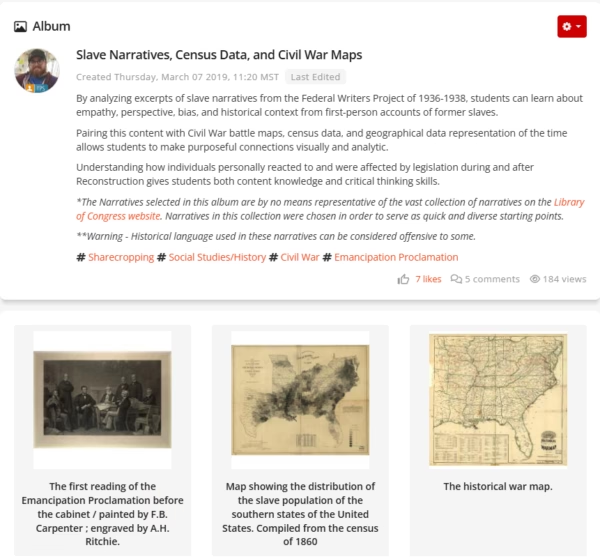
Albums are primary source sets created by members who select and curate primary sources and teaching ideas that support their unique goals. They are programmed to automatically import bibliographic information from Library of Congress collections in multiple media formats, including files, webpages, images, sound, and film. With the Album’s Teaching Notes feature, teachers can add strategies for guiding analysis and inquiry based on the primary sources they have included in their sets.
Album creators invite other Network members to comment or contribute additional content and teaching ideas. Albums are editable, searchable, adaptable, and exportable. They can be downloaded and exported as PDFs or URLs to share outside the Network.
Learning Product Archive
The work is archived, and the range of content ranges from a single engaging primary source to a curated list of primary and secondary sources related to a current event, complete lesson plans, and primary source sets. Over time, the variety of material that teachers can create, add to, learn from, and use gets richer and richer.
TPS Network Implementation
Team
The MSU Denver team manages the Network under a Library of Congress grant from the Office of Professional Learning and Outreach Initiatives. The implementation team uses ongoing analytic and qualitative data to ensure an engaging learning environment. The team stays current with industry standards and monitors activity within the Network to make continuous improvements.
Under the terms of the grant, MSU Denver handles budgetary management, procurement, and contracts necessary for the Network’s operations. The team also ensures adherence to legal, ethical, and privacy standards for professional learning platforms.
An important focus of the implementation team is to enhance the user experience by providing technical support to new and existing members, delivering network training, and maintaining a regular publication and communication schedule.
The implementation team develops, deploys, and maintains features that facilitate elements essential to a vibrant and valuable professional online community, including communication, searching, curation, and archiving.
Features
- Interest Groups allow members to find others in the Network with similar professional
interests to share resources and strategies. - Threaded Discussions extend asynchronous discussions in which users comment and
respond to original posts by other users. - Add User Reference @ tags other users in a post to acknowledge their contributions, generate notifications, and bring others into the conversation.
- Private Messaging delivers instant messages between two or more users.
Badges acknowledge individual participation within the Network using gamification strategies. - In-Network Notifications and Email Digests inform members of newly added discussions and materials posted in their interest groups.
- Pinned Posts allow group administrators to pin announcements to the top of their groups’ homepages.
- Campaign Invitations allow group administrators to invite new users to join the Network and selected groups.
Conclusion
Since its launch in 2013, the Network has grown into a vibrant online professional learning community of nearly 16,000 educators. Members enhance their ability to deepen student learning and engagement by integrating Library of Congress digitized primary sources into instruction that builds student knowledge, critical thinking, and analysis skills. The TPS Teachers Network community welcomes all educators who believe in the power of teaching with primary sources.
